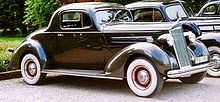Packard 120
The Packard 120 (pronounced One-Twenty ) was a passenger car that was manufactured by the Packard Motor Car Company in Detroit from 1935 to 1937 and from 1939 to 1941 . In the 1938 and 1942 model years, the One-Twenty was called Packard Eight .
The One-Twenty is an important model in Packard's history, as it was the first time the company entered the mid-range eight-cylinder market. Packard enthusiasts see the One-Twenty and One-Ten / Six as a turning point from which Packard was no longer considered the most important American luxury automobile brand.
The introduction of the One-Twenty (and later the One-Ten / Six ) had become necessary to keep Packard on the market during the last few years of the Great Depression. The reason the company didn't choose another brand name for its lower-priced cars may be because there was only one assembly line at the Grand Avenue plant and that introducing another brand would have been expensive. Because the One-Twenty was marketed as a Packard, it was quick to get out of there and it made buyers proud to own a Packard.
Model series
1935-1937
In its launch year, the Packard One-Twenty was available in a wide range of body styles. z. B. 2- and 4-door sedans, convertibles and club coupes. It was powered by an 8-cylinder SV engine that was manufactured in-house and produced 110 bhp (81 kW) at a speed of 3,850 rpm. The sales prices for the car ranged from US $ 980 for the 3-seater business coupé to US $ 1,095 for the touring sedan. When it was introduced in 1935, the car was immediately in high demand, with Packard producing 24,995 One-Twenty that year (and just 7,000 of all other models combined).
In 1936, Packard increased the displacement of the side-controlled eight-cylinder, making it 120 bhp (88 kW) and accelerating the car up to 85 mph (136 km / h). In the same year, a 4-door convertible - the most expensive model in the series with a price of US $ 1,395 - was added. In 1936, 55,042 One-Twenty were produced, the highest number this model has ever achieved in a year.
In 1937 the One-Twenty slipped a bit higher in the model range as Packard introduced the Six , the first 6-cylinder in 10 years. The One-Twenty was now also available in the equipment variants C and CD . A new model was a wooden body station wagon ("Woody"), as well as the touring sedan and a Pullman model with a wheelbase of 138 in. (3,505 mm), which cost less than $ 2,000. The 1937 model was sold from September 1936, bringing it to 50,100 units.
In 1938 the model name “Packard One-Twenty” was phased out and the model series was integrated into the Packard Eight series, analogous to the Packard Six .
1939-1941
In 1939 the One-Twenty returned to the Packard model range and was offered in many body styles from coupé to touring sedan at prices between US $ 1,099 and US $ 1,856. New this year was the steering wheel shift, which replaced the previous stick shift. The 1939 model was offered from September 1938 and brought it to 17,647 copies.
Also in 1940 a large number of body styles were offered, including a special model Cabriolet Victoria designed by Howard “Dutch” Darrin . In August 1939, the 1940s models were presented, bringing it to 28,138 units.
In the last year of production, the One-Twenty had to give up some body styles in favor of the One-Ten line. But it was still available as a business coupé, club coupé, 2 and 4-door sedans, 2 and 4-door convertibles and two different station wagons. The total production number sank to 17,100 pieces.
In 1942, the One-Ten and One-Twenty dropped out of the program and became Packard Six and Packard Eight . 125,027 Packard One-Twenty were made in seven years of production.
swell
- Beverly R. Kimes (Ed.), Henry A. Clark: The Standard Catalog of American Cars 1805-1945. Krause Publications, 1996, ISBN 0-87341-428-4 .


